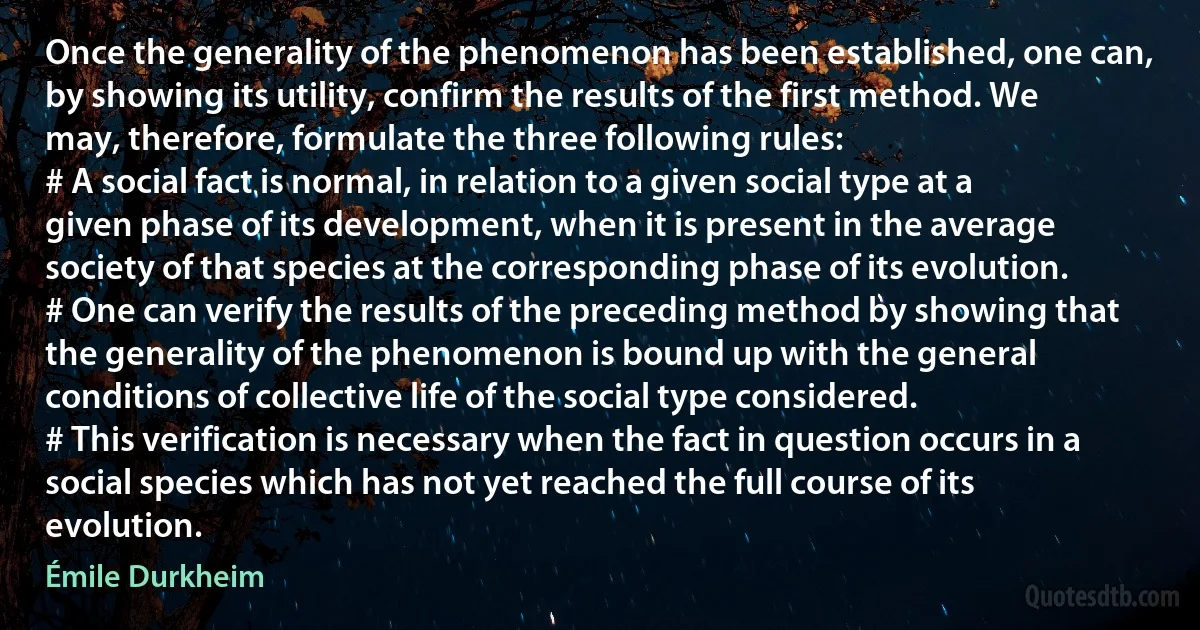
Once the generality of the phenomenon has been established, one can, by showing its utility, confirm the results of the first method. We may, therefore, formulate the three following rules: # A social fact is normal, in relation to a given social type at a given phase of its development, when it is present in the average society of that species at the corresponding phase of its evolution. # One can verify the results of the preceding method by showing that the generality of the phenomenon is bound up with the general conditions of collective life of the social type considered. # This verification is necessary when the fact in question occurs in a social species which has not yet reached the full course of its evolution.
Émile DurkheimRelated topics
bound course development evolution following full general generality given life necessary once present question showing three utility yet verification rulesRelated quotes
No honest man or woman in Germany feels responsible for these things. Good Germans took Nazism as a new religion. These people are shocked by the revelations which have shown that Nazism was not idealism, but a means to the performance of criminal acts...
In war a German feels bound to join the ranks without question. Three of my sons were called up. I could not hold back. I wrote from the concentration camp to Admiral Raeder, C. in C. of the Navy, asking to be allowed to return to the submarine service or to do any other service in the Navy. I heard nothing for several months, and then a reply came, not from Raeder but from Keitel, head of the Wehrmacht. He thanked me, but regretted I could not be employed on active service.

Martin Niemöller
I no longer believe that most traditional historians are emotionally equipped, even with training, to use their feelings as psychohistorical research tools, although there is a whole new generation of psychohistorians just now beginning to write who are able to do so. To expect the average historian to do psychohistory is like trying to teach a blind man to be an astronomer [...]. Whenever I speak to a scholar of the emotional development necessary to make a good psychohistorian and get a blank look of total incomprehension, I try to find a way to leave the subject of psychohistory altogether. My listener usually is in another world of discourse where emotional reactions are not considered crucial to the results.

Lloyd deMause
Notwithstanding all the differences in the aims and tasks of the Russian revolution, compared with the French revolution of 1871, the Russian proletariat had to resort to the same method of struggle as that first used by the Paris Commune - civil war. Mindful of the lessons of the Commune, it knew that the proletariat should not ignore peaceful methods of struggle - they serve its ordinary, day-to-day interests, they are necessary in periods of preparation for revolution - but it must never forget that in certain conditions the class struggle assumes the form of armed conflict and civil war; there are times when the interests of the proletariat call for ruthless extermination of its enemies in open armed clashes.

Vladimir Lenin
I don't have a specific picture in my mind's eye. I want to end up with a picture that I haven't planned. This method of arbitrary choice, chance, inspiration and destruction may produce a specific type of picture, but it never produces a predetermined picture. Each picture has to evolve out of a painterly or visual logic: it has to emerge as if inevitably. And by not planning the outcome, I hope to achieve the same coherence and objectivity that a random slice of nature (or a ready-made) always possesses. Of course, this is also a method of bringing in unconscious processes, as far as possible. I just want to get something more interesting out of it than those things that I can think out for myself.

Gerhard Richter
Safeguarding national honour, without rancour but with firmness demanded by the circumstances, we have recovered the southern islands which are a legitimate part of our national territory. This decision was prompted by the need to put an end to the interminable seccession of evasive and dilatory tactics used by Great Britain to perpetuate its domination over the islands and their zone of influence. That evasive attitude was considered by the national government in the present circumstances as conclusive proof of Great Britain's lack of good will to begin serious negotiations without delay over the central question of the dispute and to recognize once and for all that their alleged rights stem from an act of seizure.

Leopoldo Galtieri
